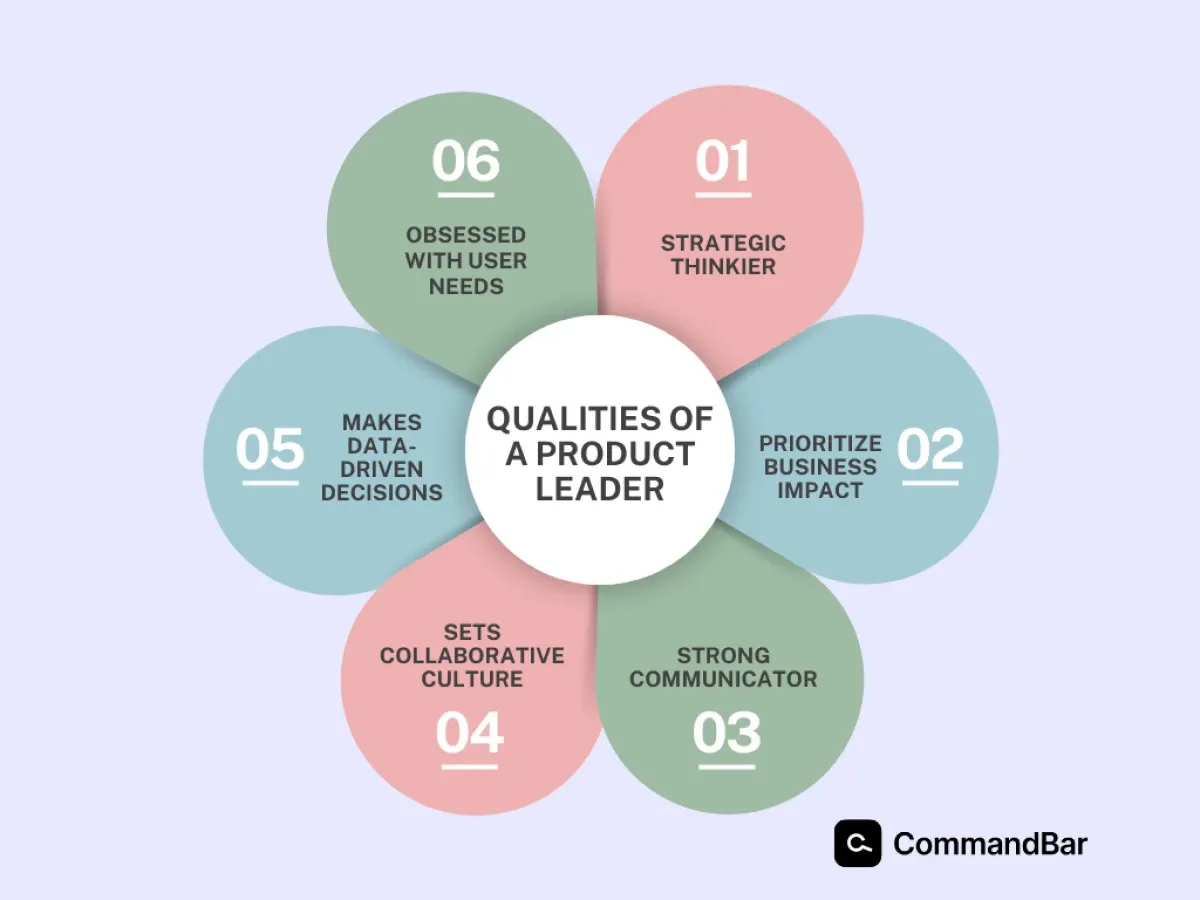A great product leadership strategy requires a lot
Discover the key skills and strategies that empower product leaders to build winning teams, drive innovation, and propel businesses toward sustainable growth. Learn how product leadership impacts everything from customer satisfaction to investor confidence.

There’s a lot more to great products than meets the eye. Take Slack, Zoom, and Salesforce for example. These industry-leading companies didn’t achieve success just by building platforms that offered awesome features. They all relied on something more – exceptional product leadership.
Building winning products requires leadership that can navigate chaos – think economic downturns, unforeseen risks, unprecedented challenges like COVID-19 – and turn what seem like vague ideas into tangible reality.
Five things a product leader needs to get right
Product leaders are the visionaries who guide the creation and evolution of products that resonate with customers and drive market success. They wear many hats, carrying the responsibility for everything from defining the product vision and roadmap to building high-performing teams and making a culture of innovation possible throughout their organization.

- Setting a clear vision for the product: What problem are we solving? Why should customers care?
- Defining the product roadmap: Not all features are created equal. Product leaders prioritize what gets built based on what the market needs and what makes the most business sense.
- Leading product development: Product leaders work hand-in-hand with engineers, designers, marketers – the entire crew – to bring product vision to life.
- Driving product adoption and growth: It's not enough to just build a product. Product leaders need to understand what users want, what's happening in the market, and how to make sure more people adopt the product over an extended period.
- Measuring success and making data-driven decisions: Product leaders use data (KPIs) to track progress, see what's working, and make changes based on what users are telling them and what the market trends show.
What skills does a great product leader possess?
Product leaders are tasked with the mandate of navigating the complexities of product development and guiding their teams toward, what are often ambitious goals.

Here's a closer look at some of the key competencies that define a strong product leader:
- Thinking strategically: A product vision serves as the North Star for the entire development process. Exceptional product leaders can articulate a clear and inspiring vision that defines the product's purpose, target audience, and the value it delivers. Such a vision needs to resonate with the team and align with the company's overall strategy.
- Prioritizing for business impact: The product roadmap isn't just a development plan – it's a strategic tool. Product leaders ensure the roadmap prioritizes features and functionalities that contribute most to achieving the company's broader goals. This ensures the product remains focused on delivering maximum business value while also remaining relevant to the customers it hopes to serve.
- Being a strong communicator to champion the product vision: Product leaders are often involved in too many areas of product development, and communication becomes a key quality for them. They need to effectively communicate with several stakeholders, both internal (engineering, design, marketing) and external (investors, partners, customers) – each of whom can have their own agendas and goals to look after. Product leaders need to be able to tailor their message to different audiences, clearly articulate the product vision, and advocate for the product's needs.
- Fostering a collaborative culture: Building a high-performing product team requires a collaborative environment. Effective product leaders excel at bringing people together, encouraging open communication, and creating a space for sharing ideas, learning, and working toward a common goal. Collaboration extends beyond the product team – it is also about building strong relationships with other departments (marketing, sales, customer experience) to ensure a successful product launch and ongoing growth.
- Making data-driven decisions: The product development world is riddled with uncertainties. Good product leaders don’t just wing it, they leverage data analytics to make informed decisions throughout the product lifecycle. They understand key performance indicators, analyze user data, and conduct market research to gather insights that guide feature prioritization, resource allocation, and overall product strategy.
- Obsessed with user needs: Exceptional product leaders are deeply attuned to their target audience. They actively seek user feedback through various channels and conduct thorough market research to identify user needs, pain points, and emerging trends. This way they can ensure the product focuses on solving real problems and deliver a positive user experience.
How product leaders build great teams
A product leader’s vision alone is not enough to bring a product to market. The success of a product also lies in the strength and capabilities of the product team. Building and leading a high-performing team is an ongoing process that requires effective leadership strategies.
Elon Musk, the head of Tesla and X (or more popularly recognized as Twitter), once defined leadership for his managers by saying,
"I am convinced that managers should work at the forefront, in the same work environment as the entire team. Even though I run the company myself, I still do not have my own office and often moved my workplace to the most challenging area in the factory and slept on the factory floor when there was a real crisis. Managers should always take care of their team before they take care of themselves – the supervisor is there to serve his team – not the other way round."
Let’s take a look at what goes into creating and maintaining a productive environment for the product team.
- Attract, develop, and retain top talent: The foundation of any team lies in its people. Product leaders play a crucial role in attracting top talent by defining the ideal candidate profile. Beyond technical skills, product leaders look for individuals who possess strong communication, collaboration, and problem-solving abilities, and who share the company's vision and values.
- Cultivate a culture of continuous learning: Product leaders understand the importance of continuous learning and development for their teams. They create a culture that encourages ongoing learning by providing access to training resources, professional development opportunities, and participation in industry conferences and workshops. This way the team can abreast of the latest trends and technologies, allowing them to approach product development with a fresh perspective and innovative ideas.
- Creating an efficient product development process: A well-defined product development process provides a roadmap for bringing ideas to life. Many product teams utilize agile methodologies, known for their iterative and flexible approach. Product leaders play a key role in establishing the chosen methodology, ensuring it aligns with the team's needs and the product's development lifecycle. In short, product leaders make sure that product management and product operations fit together.
- Optimizing workflows for speed and quality: Efficiency is crucial in product development. Product leaders streamline workflows, identifying and eliminating bottlenecks, implementing project management tools, and encouraging continuous communication across team members. This allows the team to work smarter, not harder, ensuring they deliver high-quality products within designated timelines.
- Maintaining team motivation and morale: Product development can be a demanding process. Product leaders lead with empathy and prioritize team motivation and morale. They recognize and celebrate team achievements, provide regular feedback and encouragement, and create a positive work environment where team members feel valued and appreciated.
How product leaders drive innovation and growth
Great product leaders are often relentless in their pursuit of innovation and driving growth. Here are some strategies product leaders adopt to encourage their team members to focus on innovation, identify and prioritize growth opportunities, and continuously adapt based on market data and user feedback.
Encouraging experimentation and calculated risks: Innovation often stems from taking calculated risks and exploring new ideas. Product leaders who champion experimentation create a safe space for team members to brainstorm, test hypotheses, and learn from failures. This not only fosters a culture of creativity, it also allows for the discovery of groundbreaking solutions.
Embracing new technologies and market opportunities: It is safe to say that we live in a time in history when technology is evolving exponentially. Smart product leaders stay ahead of the curve by actively researching and embracing new technologies that have the potential to revolutionize their product or industry. They are also adept at identifying emerging market opportunities and leveraging them to drive product growth. They actively seek user feedback through various channels (surveys, user interviews, A/B testing) and closely monitor market data to understand user sentiment and identify new opportunities.
The power of effective product leadership
At the heart of successful product leadership lies a potent blend of three core competencies – the ability to articulate a clear and compelling vision for the product, being adept at conveying the product vision to stakeholders and translating complex ideas into clear and actionable plans, and leveraging data analytics, embracing calculated risks, and prioritizing features that deliver the most value to achieve long-term success.
Successful product leadership often has a ripple effect throughout the organization. By delivering high-quality products that resonate with customers, product leaders contribute directly to increased revenue, profitability, and overall business success. This, in turn, leads to rising investor confidence and fuels the resources needed for continued innovation and growth.
